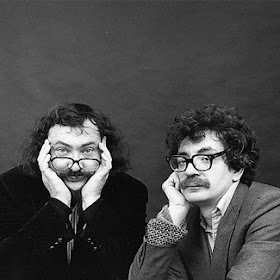Komar and Melamid is an artistic team made up of Russian-born American graphic artists Vitaly Komar (born 1943) and Alexander Melamid (born 1945). In an artists’ statement they said that “Even if only one of us creates some of the projects and works, we usually sign them together. We are not just an artist, we are a movement.” Both artists were born in Moscow, but immigrated to Israel in 1977 and subsequently to New York in 1978.
Komar and Melamid attended the Moscow Art School from 1958 to 1960, followed by the Stroganov Institute of Art and Design, graduating in 1967. They began working together shortly thereafter. After 36 years they separated in 2003.
Throughout the 1970s, Komar & Melamid also worked in a style they called “Post-Art,” pioneering the use of multi-stylistic images, prefiguring the eclectic combination of styles in post-modernism, which became popular in the 1980s. They collaborated on various conceptual projects, ranging from painting and performance to installation, public sculpture, photography, music, and poetry. In one such performance, they established a corporation, Komar & Melamid, Inc., that had as its purpose “the buying and selling of human souls.” They bought several hundred souls, including Andy Warhol’s (who sold it to them for free), which was smuggled into Russia and then sold for 30 rubles.
Melamid moved to New Jersey in 1980. He continued to work with Komar in New York. In 1981, their Portrait of Hitler was slashed by an ex-Trotskyite disc jockey in Brooklyn. They did not repair the work, considering the attacker a co-author.
Komar & Melamid created their first public art sculpture in 1986, a bronze bust of Stalin, which was installed in the red light district of The Hague, Netherlands. In 1988, they became US citizens. In 1989, a monograph about them, written by Carter Ratcliff, was published by Abbeville Press.
From 1994-1997, the artists worked on the series People’s Choice, whereby they created the “most wanted” and “least wanted” paintings of various countries based on the results of surveys conducted by professional polling companies. The book, Painting by Numbers: Komar & Melamid’s Scientific Guide to Art, published in 1997, explains the statistical underpinnings of the polling process and provides the results of each country’s preferences. Komar & Melamid used the same process in 1996-1997 in a collaboration with composer Dave Soldier to create The People's Choice Music, consisting of "The Most Wanted Song" (a love song with low male and female vocals, of moderate duration, pitch, and tempo) and "The Most Unwanted Song" (in part: an operatic soprano raps over cowboy music featuring least-wanted instruments bagpipes and tuba while children sing about holidays and advertise for Wal-Mart).
In 1998, Naked Revolution, an opera about George Washington, Vladimir Lenin and Marcel Duchamp, was created by Komar & Melamid with Dave Soldier and performed at the Walker Art Center, Minneapolis, and the Kitchen, New York. It became part of the exhibition American Dreams, along with a series of eight paintings, forty collages, and the artists’ collection of George Washington memorabilia.
In 1998, the artists also went to Thailand to teach elephants to paint, resulting in the book, When Elephants Paint: The Quest of Two Russian Artists to Save the Elephants of Thailand. In 2000, Christie's auction house held the first-ever auction of elephant paintings. The revenue generated supported the elephants and their keepers.
In 2001, Komar & Melamid began work on their last major project together, Symbols of the Big Bang, first exhibited at the Yeshiva University Museum, Center for Jewish History, New York. Using abstract symbols, the artists explored their spirituality and the connection between mysticism and science. In 2003, they began to turn some of the symbols into stained glass, which Russian authorities refused to exhibit during the Moscow portion of the exhibition, Berlin-Moscow/Moscow-Berlin (2004). Komar & Melamid ceased collaborating in 2003.
Komar and Melamid's People's Choice series, 1994–1997, consisted of the "most wanted" and "most unwanted" paintings of 11 countries. The artists commissioned polling companies in the 11 countries—including the United States, Russia, China, France, and Kenya—to conduct scientific polls to discover what they want to see in art. The use of polls was meant to mimic the American democratic process. Komar said, "Our interpretation of polls is our collaboration with various people of the world. It is a collaboration with [sic] new dictator--Majority."
Komar has said he isn't so concerned that people actually enjoy the work, so long as it provokes thoughts of free will versus predetermination. To tie that concept into their earlier work, Komar said, "In our early work, we arrived at [the] definition of freedom that entailed being free from individual clichés, being free to change intonations and styles. Individuality lost its stability and its uniqueness. Now we are searching for a new freedom. We have been traveling to different countries, engaging in dull negotiations with representatives of polling companies, raising money for further polls, receiving more of less [the] same results, and painting more or less [the] same blue landscapes. Looking for freedom, we found slavery."

